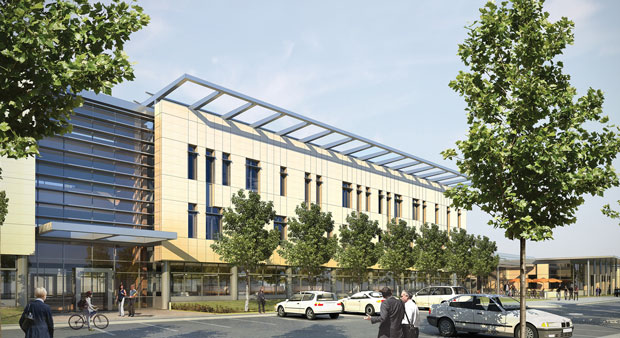Excellence in management, business, and operations and attention to the needs of the workforce complement LLNL’s outstanding performance in science and technology. FY2013 was a year of management changes, budget challenges, and steps to prepare for future successes.
Bret E. Knapp Named Acting Director
Bret Knapp has been named as the acting Laboratory director and president of LLNS, which manages Lawrence Livermore for DOE. Knapp replaces Penrose “Parney” C. Albright, who stepped down as director on October 31, 2013. Albright had served as Laboratory director since December 2011. Norman Pattiz, chairman of the LLNS Board of Governors, expressed appreciation for his “many contributions to LLNL and the nation.”
A recognized expert in national security, Knapp previously spent more than 25 years at the Laboratory, working in nuclear weapons design and testing and leading programs in defense and nuclear technology development. In 2006, he joined the senior management team at Los Alamos National Laboratory, recently serving as principal associate director for the weapons program.
Creating the Laboratory’s Future
Planning processes, program development efforts, and workforce adjustments in FY2013 set the stage for future programmatic successes. These efforts were complemented by initiatives to enhance work-environment quality. For example, LLNL implemented a policy that enables use of personal electronic devices (PEDs) in most workplaces. Previous restrictions limited PED use, which was an impediment to attracting scientific talent. Best practices and lessons learned were shared throughout NNSA.
Planning activities included a major update to the science, technology, and engineering investment roadmap. The roadmap describes new initiatives and strategic focus areas for program growth. It also identified core competencies that distinguish the Laboratory and are the focus of continual reinvestment to ensure future mission success. Possible future line-item investments at Livermore include six prospective projects submitted in LLNL’s site plan and highly ranked by NNSA. We are working with NNSA to begin implementing an Electrical Infrastructure Upgrade Project.
Among the program-growth successes in FY2013, LLNL was awarded more than $45 million to develop and deliver a state-of-the-art laser system for the European Union’s Extreme Light Infrastructure Beamlines facility, under construction in the Czech Republic. The agreement, which will deliver a laser system utilizing groundbreaking technologies, was a successful pioneering implementation of the DOE Agreement for Commercializing Technology (ACT) pilot program. Another key success was approval of the California Energy Systems for the 21st Century initiative (see Energy and Environment ).
Facing the prospect of future austere budgets in FY2014 and beyond, LLNS conducted a Self-Select Voluntary Separation Program to right-size the Laboratory for the future. Altogether, 399 employees chose to participate in the program, many with long and dedicated LLNL careers. Their collective years of service represent an extraordinary commitment to the Laboratory.
Livermore Valley Open Campus Growth
In April 2013, NNSA approved Critical Decision-0 for the development of the Livermore Valley Open Campus (LVOC), a 110-acre site at the eastern edge of Livermore and Sandia–California national laboratories. The two laboratories are finalizing input to support a Critical Decision-1 to acquire two new major facilities at LVOC. LLNL’s existing High Performance Computing Innovation Center at LVOC has hosted 16,000 visitors and 1,700 events since opening in June 2011. A much larger new facility is needed to further expand high-performance computing partnership projects. In March 2013, LLNS released a request for information from parties interested in potential leases at LVOC.
Certified Quality Management and Assurance
Following an audit of LLNL’s Quality Management System (QMS) in the summer of 2013, the auditor recommended ISO 9001 certification for the Laboratory. Certification is indicative that systems are in place for LLNL managers to make informed decisions based on employee feedback, internal assessments, external audits, and other tools for continual improvement. QMS is complemented by LLNL’s Contractor Assurance System (CAS), which continues to mature. CAS is used to measure, improve, and demonstrate performance. It is a primary tool of the Laboratory’s Management Assurance System, which provides assurance to NNSA that LLNL’s mission objectives and contract requirements are met.
LLNS Board of Governors Activities
The LLNS Board of Governors and its committees provide oversight in critical areas related to mission and mission-support activities. The committees delve into their specific areas, and members participate in external review committees and Functional Management Reviews (FMRs). In FY2013, LLNS held four Directorate Reviews and six FMRs in selected topical areas. FMRs provided recommendations to improve preventative maintenance, expert evaluation of the effectiveness of LLNL nuclear safety basis procedures, validation of selected safety procedures, affirmation that LLNL’s CAS meets requirements, and assistance to better integrate LLNL’s and LANL’s cyber risk management programs. Nearly 100 reviews have been conducted since 2007, resulting in more than 480 recommendations acted on by LLNL managers to improve Laboratory performance.
Small Business Outreach
In FY2013, LLNL procured through small businesses 62.6 percent of the $350 million spent for services and supplies, exceeding the DOE goal (which increased to 52 percent in FY2013) for the third straight year. Michelle Quick, Small Business Program Manager, and Kelly Miller, Supply Chain Management department head (seated left to right, with contract administrators Larry LeBel and Becky Ip), display the Small Business Achievement of the Year award received from DOE the previous year for outstanding performance.









